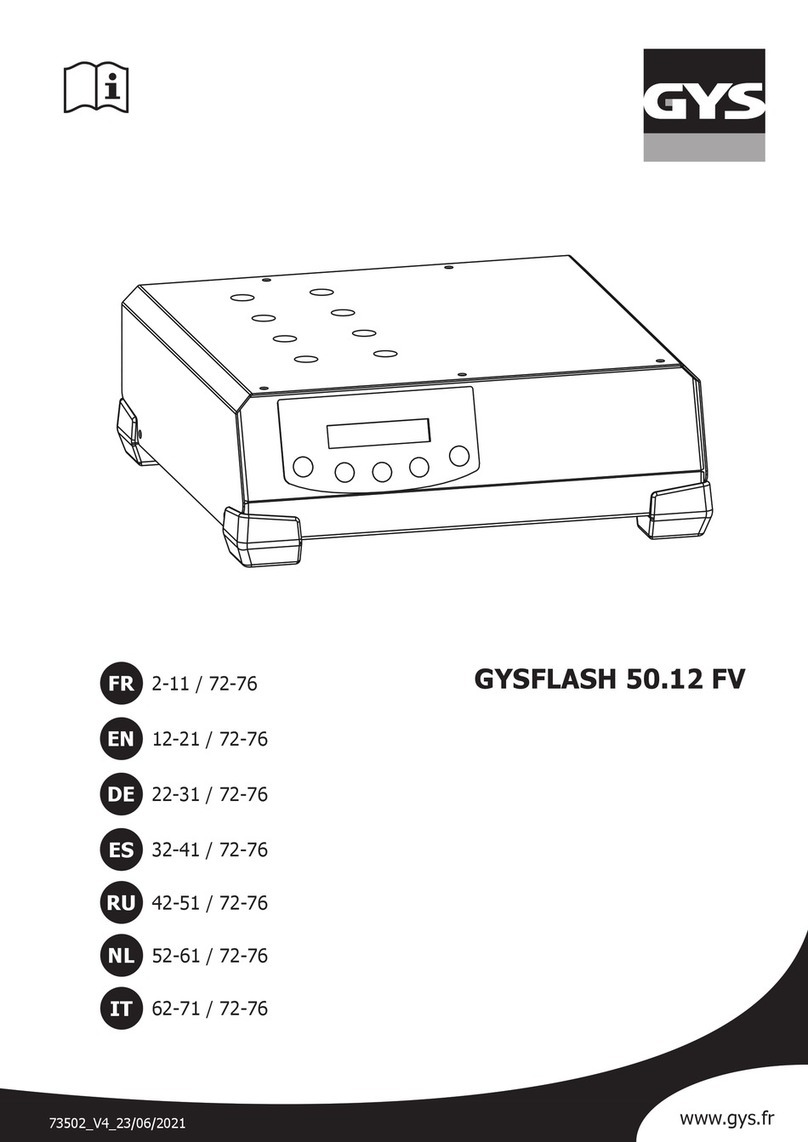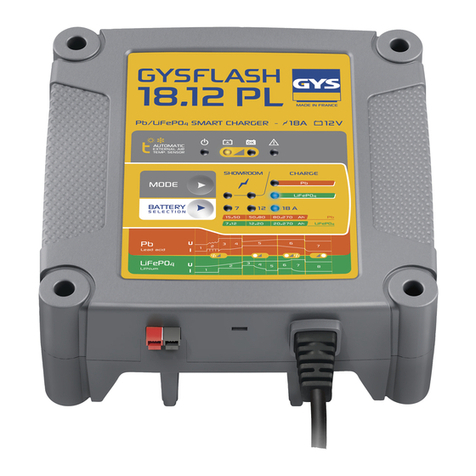GYS Energy station User manual

73535-V5-01/06/2016
Sommaire
Description générale............................2
Montage ............................................2
Utilisation : mise en garde ...................3
Fonction démarreur.............................3
Fonction testeur des batteries internes.4
Fonction chargeur de batterie ..............4
Anomalies, causes, solutions................6
Conseils et avertissements ..................7
Certificat de garantie...........................8
Attestation de conformité ..................44
Pictogrammes...................................45
Spécifications techniques...................48
Contents
General description.............................9
Assembly ...........................................9
Use: warning.................................... 10
Starter mode.................................... 10
Internal batteries tester mode .......... 11
Starter mode.................................... 11
Anomalies, causes, remedies............. 13
Advice and warnings......................... 14
Declaration of compliance................. 44
Symbols........................................... 45
Technical specifications..................... 48
16-22/44-48
23-29/44-48
30-36/44-48
37-43/44-48

2/47
Energy Station
Nous vous félicitons pour votre choix car cet appareil a été conçu avec le plus grand soin.
Pour en tirer le maximum de satisfaction, nous vous conseillons de lire avec attention ce
manuel d'instruction. Conserver le pour pouvoir le relire plus tard si nécessaire.
Description générale
Energy Station est un démarreur autonome destiné au démarrage des véhicules équipés
d’une batterie de 12 V / 24V. Le chariot permet de positionner 1 ou 2 batteries de 12V (6
éléments de 2V) d’une capacité allant jusqu’à 180 Ah chacune. L’appareil intègre 2 chargeurs
de batterie automatiques pour charger les batteries internes mais aussi externes ainsi qu’un
testeur de batterie. En mode démarreur, l’électronique du véhicule est protégée contre les
surtensions.
Montage
Chariot
Visserie : 4 vis tôle, 8 vis M5x12, 2 vis M6x50, 30 vis M8x12, 30 écrous M8
Outils nécessaires au montage (non fournis): 1 jeu de clé 6 pans, 1 clé plate de 10 et de 8 et
1 tournevis avec embout torx T20 (pour la poignée)
M8
x12
M8
x12
M5
x12
M8
x12
M5
x12
M6
X50
Vis
tôle
Vis
tôle

3/47
Energy Station
Batteries Internes et pinces de charge
Avant toute utilisation, installer les deux batteries
« internes » (non fournies): batteries au plomb à électrolyte
liquide ou gel 12V d’une capacité de 120 à 180 Ah maximum
chacune. Leurs dimensions ne doivent pas excéder 45x
53x23 cm et le poids total max 100 kg.
Pour les installer :
Débrancher le cordon secteur ou mettre l’interrupteur de
charge en position « 0 ».
Fixer les 4 colliers de serrage fournis sur les 4 câbles.
Raccorder les batteries à l’Energy Station en respectant
les polarités :
-câble rouge au + de la batterie.
-câble noire au – de la batterie.
Utilisation : mise en garde
En position repos, les pinces de
charges doivent impérativement être
placées sur leur support et non sur la
poignée sous risque d’arc électrique et
court-circuit, avec pour conséquence la
décharge profonde des batteries.
Fonction démarreur
Mode 12V
•Débrancher le cordon secteur ou mettre l’interrupteur de
charge en position « 0 ».
•Connecter les câbles sur les sorties de la batterie 1 ou 2.
•Connecter les pinces sur la batterie du véhicule à démarrer en
respectant les polarités.
•Tourner la clé de votre véhicule, pour activer la fonction
démarreur.
Nb : Si votre moteur ne démarre pas, attendre 3 minutes
entre 2 tentatives de démarrage.
•Recharger les batteries après utilisation (cf. fonction
chargeur).
Mode 24V
•Débrancher le cordon secteur ou mettre l’interrupteur de
charge en position « 0 ».
•Connecter les câbles sur la sortie 24V.
•Connecter les pinces sur la batterie du véhicule à démarrer en
respectant les polarités.
ou
ou
ou
OUI
NON
23
cm

4/47
Energy Station
•Tourner la clé de votre véhicule, pour activer la fonction
démarreur.
Nb : Si votre moteur ne démarre pas, attendre 3 minutes
entre 2 tentatives de démarrage.
•Recharger les batteries après utilisation (cf. fonction
chargeur).
Fonction testeur batteries internes
Pour tester les batteries de l’Energy Station :
•Débrancher le cordon secteur ou mettre l’interrupteur de charge en
position « 0 ».
•Appuyer sur le bouton de la batterie à tester, le résultat s’affiche :
Voyant vert : batterie chargée (tension supérieure à 12.8V).
=> démarrage possible.
Voyant orange : batterie partiellement chargée (tension comprise entre
12.8V et 12.4V), => il est fortement conseillé de
recharger avant utilisation.
Voyant rouge : batterie déchargée (tension inférieure à 12.4V).
=> démarrage impossible.
Aucun voyant : pas de batterie détectée ou batterie très déchargée
(<6V)
=> démarrage impossible.
Nb : Le test n’est significatif que si la batterie est au repos depuis au moins 15 minutes.
Fonction chargeur
Recharge batteries internes de l’Energy Station
Pour que l’Energy Station soit toujours opérationnel et pour qu’il délivre la puissance de
démarrage maximale, il est conseillé de le charger après chaque utilisation et de le laisser en
charge jusqu’à la prochaine utilisation.
L’Energy Station intègre 2 chargeurs automatiques qui chargent et qui gardent chargé à
100% et sans surveillance les 2 batteries internes (Floating System).
Pour charger les batteries internes :
•Brancher le chargeur sur l’alimentation secteur 230V 50/60Hz.
•Mettre l’interrupteur du chargeur en position « I ».
•Avant de débuter la charge, l’appareil vous indique l’état de la batterie
pendant 2 sec. :
Voyant rouge : batterie est fortement déchargée.
Voyant orange : batterie est déchargée mais un démarrage est
envisageable.
Voyant vert : batterie est chargée.
ou

5/47
Energy Station
•L’appareil vous indique ensuite l’état de la charge :
Voyant orange fixe : charge – montée de tension de la
batterie. (12 heures max)
Voyant orange clignotant – régulation de la tension (2h ou 24
heures si la batterie est sulfatée).
Voyant vert : batterie chargée. Démarrage possible. Laisser
l’appareil branché sur le secteur si vous ne l’utilisez pas.
Recharge batteries externes.
Le chargeur peut charger des batteries 12V ou 24V à l’électrolyte liquide ou gel de 35 Ah à
225 Ah.
En mode 12V : afin de recharger rapidement les batteries externes, il est conseillé que la
batterie interne de la sortie choisie soit chargée.
En mode 24V : il est impératif d’avoir les batteries présentes et chargée.
Pour charger les batteries externes :
•Connecter les câbles sur les sorties nécessaires 12V (sorties 1 ou 2), 24V
•Relier les pinces (+ rouge et – noire) aux bornes + et – de la batterie en
assurant un bon contact.
•Brancher le chargeur sur une alimentation secteur 230V 50/60Hz.
•Mettre l’interrupteur du chargeur en position « I ».
•Avant de débuter la charge, l’appareil vous indique l’état des 2 batteries
additionnées pendant 2 sec. :
Voyant rouge : batterie est fortement déchargée.
Voyant orange : batterie est déchargée mais un démarrage
est envisageable.
Voyant vert : batterie est chargée.
•L’appareil vous indique ensuite l’état de la charge :
Voyant orange fixe : charge – montée de tension de la
batterie.
(12 heures max)
Voyant orange clignotant – régulation de la tension (2 ou 24
heures si la batterie est sulfatée)
Voyant vert : batterie chargée.
en position 24V : attendre que les voyants des 2 chargeurs
soit dans cette position.
•Quand la batterie est chargée, positionner l’interrupteur sur 0.
•Débrancher le câble d’alimentation.
•Débrancher les pinces.
ou

6/47
Energy Station
Anomalies, causes, remèdes
CONSTATATIONS
CAUSES
remèdes
MODE DÉMARREUR
Le véhicule ne démarre
pas.
Les batteries
internes sont
déchargées.
Vérifier l’état des batteries internes
en appuyant sur les boutons test.
Recharger les si nécessaire.
Vous avez effectué
plusieurs essais de
démarrage sans
pause.
Attendre 3 minutes entre 2
tentatives de démarrage.
Un démarrage ne doit pas durer
plus de 7 secondes.
Erreur tension.
Vérifier que la tension de
démarrage sélectionnée correspond
bien à la tension de la batterie du
véhicule.
De violentes étincelles
apparaissent au
moment du contact
des pinces sur la
batterie du véhicule.
Erreur de tension.
Vérifier que les branchements et
que la tension de démarrage
correspond bien à la tension
sélectionnée.
Inversion de
polarité.
Brancher le câble rouge sur la
borne (+) de la batterie et le câble
noir sur la borne (-).
Les batteries internes
sont chargées, le choix
de la tension de
démarrage est correct
mais le véhicule ne
démarre pas.
Problème véhicule
(redresseur,
démarreur, bougies
de préchauffage…)
Se rapprocher d’un professionnel.
MODE CHARGEUR
La led rouge clignote
(après 24h de charge).
La batterie ne prend
pas la charge ou sa
tension ne monte
pas suffisamment.
Vérifier que les colliers sont bien
serrés sur les bornes de la batterie.
Nettoyer les bornes et redémarrer
la charge. Si la led rouge clignote à
nouveau, vos batteries sont
endommagées.
Les leds orange et
verte clignotent tour à
tour pendant la
charge.
Protection thermique
du chargeur.
Attendre quelques minutes (5 à 10
minutes) pour laisser refroidir
l’appareil. La charge reprendra
automatiquement dès que la
température aura suffisamment
chutée.
La Led orange clignote
pendant plus de 3h et
ne passe pas au vert.
La batterie est
sulfatée ou
fortement
déchargée.
Le chargeur détecte la présence
d’une
batterie sulfatée ou
profondément déchargée. Il
tentera
de la restaurer avec une char
ge
spécifique de 24h.

7/47
Energy Station
Aucune led ne s’allume
Le fusible a fondu :
surintensité sur
d’alimentation
secteur.
Remplacer le fusible. Vérifier votre
alimentation secteur.
Pas de batterie.
Le chargeur ne détecte pas de
batterie ou votre batterie est
irrécupérable (tension >0,5V).
Inversion de polarité
des batteries.
Brancher le câble rouge sur la
borne (+) de la batterie et le câble
noir sur la borne (-)
Problème
d’alimentation
secteur. Vérifier votre alimentation secteur.
En mode 24V, les
voyants de charge
orange et vert
clignotent
anormalement
Pour charger une
batterie externe de
24V, Energy Station
a besoin de ses 2
batteries internes
pour fonctionner.
Positionner la ou les batteries
internes manquantes.
MODE TESTEUR
Après avoir appuyé sur
le bouton test, aucun
voyant ne s’allume.
L’appareil est
branché sur le
secteur et
l’interrupteur charge
est allumé.
Eteindre l’appareil (interrupteur
charge sur 0) ou déconnecter le
chargeur du secteur 230V. Appuyer
à nouveau sur le bouton de test.
Il n’y a pas de
batterie.
Vérifier les branchements de la
batterie interne (colliers de
serrage…)
La tension de la
batterie est trop
faible.
Dans ce mode, le chargeur
s’alimente à travers la batterie à
tester. Si la tension de la batterie
est trop faible (<6V), aucune led
ne s’allume.
2 leds clignotent par
intermittence
Le test s’actualise
toutes les 0.5
secondes. La tension
de la batterie se
situe sur le seuil de
basculement.
Lors de la lecture, prendre le cas le
plus défavorable
Conseils et avertissements
•Gaz explosif, éviter les flammes et les étincelles. Pendant la charge, la batterie doit être
placée dans un emplacement bien aéré.
•Protéger l’appareil contre la pluie et l’humidité.
•L’appareil doit être relié à un socle de prise de courant 230 V relié à la terre.
•L'appareil doit être placé de façon telle que la fiche de prise de courant soit accessible.
•Examiner l’Energy Station régulièrement, en particulier le câble, la fiche et l’enveloppe, pour
détecter tout dommage. Si l’appareil est endommagé, il ne doit pas être utilisé avant sa
réparation.

8/47
Energy Station
•Si le câble d’alimentation est endommagé, il doit être remplacé par le fabricant, son service
après vente ou une personne de qualification similaire, afin d’éviter un danger.
•Fonction chargeur : La borne de la batterie non reliée au châssis du véhicule doit être
connectée la première. L’autre connexion doit être effectuée sur le châssis loin de la
batterie et de la canalisation de combustible.
•Fonction chargeur : Après l’opération de charge, débrancher le chargeur du réseau, puis
retirer la connexion du châssis du véhicule et la connexion de la batterie, dans l’ordre
indiqué.
•Produit faisant l'objet d'une collecte sélective. Ne pas jeter dans une poubelle domestique.
•L’appareil ne doit pas être utilisé comme un jouet par de jeunes enfants, ou être utilisé par
de jeunes enfants ou personnes handicapes sans surveillance.
•A n'utiliser en aucun cas pour charger des piles ou des batteries non-rechargeables.
•Ne pas mettre en court circuit les pinces pendant la charge.
•Ne pas ouvrir l’appareil. Toute modification non effectuée par un technicien de la société
GYS entraîne l’annulation de la garantie et de la responsabilité de la société GYS.
•Lorsque L’Energy Station est équipé de batteries internes, il est conseillé de le déplacer
l’horizontal. Afin d’éviter de faire déborder le liquide des batteries, n’accepter que pendant
de très courts instants des angles de 35° maximum.
Conditions de garantie
La garantie couvre tous défauts ou vices de fabrication pendant 1 an, à compter de la date
d’achat (pièces et main d’oeuvre).
La garantie ne couvre pas :
• Toutes autres avaries dues au transport.
• L’usure normale des pièces (Ex. : câbles, pinces, etc.).
• Les incidents dus à un mauvais usage (erreur d’alimentation, chute, démontage).
• Les pannes liées à l’environnement (pollution, rouille, poussière).
En cas de panne, retourner l’appareil à votre distributeur, en y joignant :
- un justificatif d’achat daté (ticket de sortie de caisse, facture….)
- une note explicative de la panne.

9/47
Energy Station
Congratulations for the selection of this product which has been designed with a great care.
To get the best of it, please read carefully the following instructions. Keep this instruction
manual safe, you may want to read it again later.
General description
Energy Station is an autonomous starter designed to start vehicles with a 12V or 24V battery.
The trolley enables to place 1 or 2 12V batteries (6 2V cells) for a capacity up to 180Ah each.
The machine integrates 2 automatic battery chargers to charge the internal and external
batteries and a battery tester. In starter mode, the electronic of the vehicle is protected
against overvoltage.
Assembly
Trolley
Fastenings : 4 screws, 8 M5x12 screws, 2 M6x50 screws, 30 M8x12 screws, 30 M8 nuts.
Tools necessary for the assembly (not provided): 1 set of Allen keys, 1 wrench of 10 and 8, 1
screwdriver with screwdriver bit torx T20 (for the handle)
M8
x12
M8
x12
M5
x12
M8
x12
M5
x12
M6
X50
screws
screws

10/47
Energy Station
Internal batteries and charging clamps
Before any use, instal both « internal batteries » (not
provided) : 12V lead batteries with liquid or gel electrolyte of
a maximum capacity of 120 to 170 Ah each. Their
dimensions must not exceed 45x 53x23 cm, and 100 kg for
the total weight.
To install them:
Unplug the power supply cable or place the charging
switch on « 0 ».
Fasten the 4 collars supplied on the 4 cables.
Connect the batteries to the Energy Station respecting the
polarities:
-Red cable to the battery +
-Black cable to the battery –
Use: warning
In rest position, the charging
clamps must absolutely be placed on
their support and not on the handle
which could risk electrical arcs and
short circuits resulting in a highly
discharge of the battery.
Starter mode
12V Mode
•Unplug the power supply cable or place the charging switch
on « 0 ».
•Connect the cables to the battery outputs 1 or 2.
•Connect the clamp to the battery of the vehicle to start
respecting the polarities.
•By switching on the ignition key, you will activate the starter
function.
Nb : Your engine does not start, wait for 3 minutes between
2 starting attempts.
•Charge the batteries after using. (see charger mode)
24V Mode
•Unplug the power supply cable or place the charging switch
on « 0 ».
•Connect the cables to the 24V output.
•Connect the clamps on the vehicle battery to start respecting
the polarities.
or
or
or
YES
NO
23
cm

11/47
Energy Station
•By switching on the ignition key, you will activate the starter
function.
Nb : Your engine does not start, wait for 3 minutes between
2 starting attempts.
•Charge the batteries after using. (see charger mode)
Internal batteries tester mode
To test the Energy Station batteries:
•Unplug the power supply cable or place the charging switch on
« 0 ».
•Press the key of the battery to test and the result displays:
Green light: battery charged (voltage above 12.8V).
=> starting possible.
Orange light : battery partially charged (voltage in between 12.8V and
12.4V), => it is highly advised to charge before using.
Red light: battery discharged (voltage below 12.4V)
=> starting impossible
No light: no battery detected or battery highly discharged (<6V)
=> starting impossible
Nb : The test is only relevant if the battery rested for at least 15 minutes.
Charger mode
Charging of the Energy station internal batteries
In order for the Energy station to be always operational, and to deliver the maximum starting
power, it is recommended to charge the batteries after each use and to keep them on charge
until the next use.
The Energy Station integrates 2 automatic chargers which charge and keep fully charge
without watch the 2 internal batteries (Floating System).
To charge the internal batteries:
•Plug the charger to the mains 230V 50/60Hz.
•Switch on « I ».
•Before starting the charge, the machine indicates the battery condition for 2
sec. :
Red light: Battery highly discharged.
Orange light: battery discharged but a starting is possible.
Green light: battery is charged.
or

12/47
Energy Station
•The machine indicates the charge condition:
Permanent orange light: charge – battery voltage increase. (12
hours max)
Blinking orange light – voltage regulation (2h or 24 hours if the
battery is sulfated)
Green light: battery charged. Starting possible. Let the
machine plugged to the mains if not used.
Charging of the external batteries.
The charger can charge 12V batteries with liquid or gel electrolyte of 35 Ah to 225Ah.
In 12V mode: to quickly charge the external batteries, it is advised the internal battery of the
chosen output is fully charged.
In 24V mode: it is imperative to have the battery fully charged.
To charge the external batteries:
•Connect the cables to the required 12V or 24V outputs (output 1 or 2).
•Connect the clamps: Red clamp on the battery “+” and black clamp
on the “–“..
•Plug the charger to the mains 230V 50/60Hz.
•Switch on « I ».
•Before starting the charge, the machine indicates the condition of both
batteries added for 2 sec.:
Red light: battery highly discharged.
Orange light: battery is discharged but a starting is possible.
Green light: battery is charged.
•Then, the machine indicates the charging condition:
Permanent orange light: charge – battery voltage increase.
(12 heures max)
Blinking orange light – voltage regulation (2 or 24 hours if
the battery is sulfated)
Green light: battery charged.
In 24V setting: wait for the 2 chargers indicators to be on
this position.
•When the battery is charged, switch off « 0 »
•Unplug the the power supply cable
•Disconnect the clamps
oror

13/47
Energy Station
Anomalies, causes, remedies
ANOMALIES
CAUSES
REMEDIES
STARTER MODE
The Vehicle does not
start
The internal batteries
are discharged.
Check the internal batteries
condition by pressing the test
keys.
Charge if necessary.
Several starting were
attempted without
break.
Wait for 3 minutes between 2
starting attempts.
A starting must not last more
than 7 seconds.
Voltage error
Check the starting voltage
selected matches the vehicle
battery voltage.
Intense sparks when
connecting the clamps to
the vehicle battery.
Voltage error
Check the connections and
that
the starting voltage
matches the selected voltage.
Polarity reversal.
Connect the red cable to the
(+)
battery terminal and the
black cable to the (-) terminal.
The internal batteries are
charged, the starting
voltage choice is right,
but the vehicle does not
start.
Vehicle problem
(rectifier, starter, glow
plugs…)
Take contact with a
professional.
CHARGER MODE
The red light blinks (after
24h of charge)
The battery does not
charge or its voltage
does not increase
enough.
Check the collars are well
tightened on the battery
terminals. Clean the terminals
and restart the charge. If the
red light blinks again, the
batteries are damaged.
The green and orange
lights blink turn by turn
while charging.
Charger thermal
protection.
Wait for several minutes (5 to
10 minutes) to cool the
machine. The charge will
automatically restart as soon
as the temperature will have
decreased enough.
The orange light blinks
for more than 3h and
does not change to
green.
The battery is sulfated
or highly discharged.
The charger detects the
presence of a sulfated or
highly discharged battery. It
will attempt to restore it with a
24h specific charge.

14/47
Energy Station
No lights are on.
The fuse melt :
Problem with the
power supply
Replace the fuse
: Check the
power supply.
No batteries
The charger does not detect
the battery or the battery is
damaged beyond repair
(voltage >0,5V).
Batteries polarities
reversal
Connect the red cable to the
(+) battery terminal and
the
black cable to the (-) terminal
Problem with the
power supply Check the power supply.
In 24V mode, the green
and orange charge
indicators blink
abnormally.
To charge a 24V
external battery, the
Energy Station needs
its 2 internal batteries
to operate.
Place the missing internal
batterie(s).
TESTER MODE
After having pressed the
test key, no light
indicators are on.
The machine is
plugged on the mains
and the charging
switch is on.
Switch off the machine.
(charging switch on 0) or
disconnect the charger from
the mains 230V. Press again
the test key.
There is no battery.
Check the internal battery
connections (fastening
collars…)
The battery voltage is
to low.
In this mode, the charger is
supplied through the battery
to test. If the battery voltage
is to low (<6V), no led will
switch on.
2 leds blink intermittently.
The test updates every
0.5 seconds. The
battery voltage is on
the rocking threshold.
While reading, take the most
unfavorable case.
Advice and warnings
•Explosive gas, avoid flames and sparks. While charging, the battery must be in a ventilated
area.
•Protect the machine against the rain and humidity.
•The machine must be installed so that the mains plug is accessible.
•The product must be plugged to a base with a 230V plug with earth.
•Check regularly the Energy Station, specially the power cord, the plug and the case, to
detect any damage. If the charger is damaged, it must not be used before reparation.
•If the electricity supply cable is damaged, it must be replaced by the manufacturer, its after
sales service, or a person with the same qualifications to avoid any dangers.
•Charger Mode : the battery terminal which is not connected to the frame must be
connected first. The other connection must be done on the frame far from the battery and
from the fuel system.

15/47
Energy Station
•Charger Mode : after charging, disconnect the charger from the outlet, then disconnect the
clamp from the frame and the battery in the indicated order.
•Separate collection required – do not throw in a domestic dustbin.
•The product must not be used as toy by young children, or used by young children or
disabled persons without any supervision.
•Do not used in any cases to charge small batteries or non rechargeable batteries.
•Do not make the clamps enter in short circuit during the charge.
•Do not open the product. All modification or attempt of modification not done by a
technician of GYS can lead to the cancellation of the warranty of the product and of the
responsibility of the firm GYS on this product.
•When the Energy station is equipped with internal batteries, it is recommended to move it
horizontally. To avoid the batteries liquid overflowing, only accept for very short times
angles of 35° maximum.

16/47
Energy Station
Wir freuen uns, dass Sie sich für ein Markengerät der Firma GYS entschieden haben und
danken Ihnen für das entgegengebrachte Vertrauen. Um das Gerät optimal nutzen zu
können, lesen Sie bitte die Betriebsanleitung sorgfältig durch.
Beschreibung
Energy Station ist eine multifunktionelle mobile Anlage, die entwickelt wurde, um Fahrzeuge
mit 12V oder 24V Batterien zu starten. Sie besteht aus zwei automatischen
Batterieladegeräten für interne und externe Batterien sowie Batterietester. Der Fahrwagen
ermöglicht Platz für eine bis zwei 12V Batterien mit Kapazitäten bis zu jeweils 180 Ah. Im
«Start» Modus ist die Bordelektronik gegen Überspannungen geschützt.
Montage des Fahrwagens
Fahrwagen
Befestigung mit: 4 Schrauben, 8 M5x12 Schrauben, 2 M6x50 Schrauben, 30 M8x12
Schrauben, 30 M8 Muttern
Werkzeug für die Montage (nicht im Lieferumfang enthalten): 1 Satz Inbusschlüssel, 1
Schlüssel für 10 und 8, 1 Schraubenzieher mit Bit Torx T20 (für den Griff)
M8
x12
M8
x12
M5
x12
M8
x12
M5
x12
M6
X50
Schrauben
Schrauben

17/47
Energy Station
JA
NEIN
Interne Batterien und Ladeklemmen
Verbinden Sie, bevor Sie das Gerät anwenden, die beiden
internen Batterien (nicht im Lieferumfang enthalten) wie
folgt an:
Interne Batterien: 12V Bleibatterien (flüssig oder Gel) jeweils
mit einer Kapazität zwischen 120- 170Ah; Abmaße nicht
größer als 45x 53x23 cm, und Gesamtgewicht nicht größer
als 100 kg.
Ziehen Sie den Netzstecker oder stellen Sie den
Ladeschalter auf «0»
Befestigen Sie die 4 mitgelieferten Kabel an die 4 Pole der
Batterien
Verbinden Sie die Batterien mit der Energy Station
Beachten Sie die Polarität:
-Rote Klemme an „+“ Pol
-Schwarze Klemme an „-“ Pol der Batterie
ACHTUNG!
Im Ruhezustand müssen die
Klemmen an die seitlichen Stützen der
Energy Station aufgehängt werden!
Befestigen Sie die Klemmen unter keinen
Umständen am Griff, da es zum
Kurzschluss kommen oder ein Lichtbogen
entstehen kann, was in beiden Fällen zu
einer Entladung der Batterie führt.
Startfunktion
12V Modus
•Trennen Sie den Netzstecker vom Netz oder stellen Sie den
Ladeschalter auf «0»
•Schließen Sie das Ladekabel an die Anschlüsse 1 oder 2 der
Batterien
•Verbinden Sie die rote Klemme mit dem «+» Pol und die
schwarze Klemme mit dem «-» Pol der Batterie
•Starten Sie das Fahrzeug.
Hinweis: Begrenzen Sie die Startzeit auf max. 7 Sekunden
und pausieren Sie zwischen den Versuchen jeweils 3 Minuten,
damit die Batterie sich erholen kann
•Schießen Sie das Gerät nach der Anwendung ans Stromnetz
an, damit sich die Batterien aufladen können
oder
oder
23
cm

18/47
Energy Station
24V Modus
•Trennen Sie den Netzstecker vom Netz oder stellen Sie den
Ladeschalter auf «0»
•Schließen Sie das Ladekabel an die 24V- Buchse an
•Verbinden Sie die rote Klemme mit dem «+» Pol und die
schwarze Klemme mit dem «-» Pol der Batterie
•Starten Sie das Fahrzeug.
Hinweis: Begrenzen Sie die Startzeit auf max. 7 Sekunden
und pausieren Sie zwischen den Versuchen jeweils 3 Minuten,
damit sich die Batterie erholen kann
•Schießen Sie das Gerät nach der Anwendung ans Stromnetz
an, damit sich die Batterien aufladen können
Test der internen Batterien
Um die internen Batterien der Energy Station zu testen, gehen Sie wie folgt vor:
•Trennen Sie den Netzstecker vom Netz oder stellen Sie den
Ladeschalter auf «0»
•Drücken Sie die „Test“- Taste um die Batterie zu testen.
Das Gerät zeigt Ihnen den Ladezustand der Batterie an:
Grüne Anzeige leuchtet: Batterie ist geladen (Spannung liegt über 12.8V)
=> Startvorgang möglich.
Orange Anzeige leuchtet: Spannung liegt zwischen 12.8V und 12.4V
=> Laden Sie die Batterie auf
Rote Anzeige leuchtet: Batterie ist entladen (Spannung liegt unter 12.4V)
=>Startvorgang nicht möglich
Keine Anzeige: keine Batterie erkannt oder die Batterie ist sulfatiert oder
tiefentladen (<6V)
=> Startvorgang nicht möglich
Hinweis: Führen Sie den Batterietest erst aus, wenn sich die Batterie seit mindestens 15min
im Ruhezustand befindet
Ladefunktion
Laden der internen Batterien
Um zu gewährleisten, dass die Energy Station immer betriebsbereit ist und maximale Leistung
erbringt, sollten Sie nach jeder Anwendung die internen Batterien aufladen und das Gerät am
Netz angeschlossen lassen.
Die Energy Station verfügt über den Modus «Floating»; das bedeutet 100%ige Aufladung
ohne Überwachung.
•Schließen Sie das Ladegerät an ein 230V Stromnetz 50/60Hz an
•Schalten Sie den Ladeschalter auf «I»
oder
oder

19/47
Energy Station
•Vor dem Start des Ladevorgangs zeigt Energy Station für 2 Sek. den
Batteriezustand an:
Rote Anzeige leuchtet: Batterie ist entladen
Orange Anzeige leuchtet: Batterie ist entladen; Start ist jedoch
möglich
Grüne Anzeige leuchtet: Batterie ist aufgeladen
•Energy Station zeigt Ihnen den Ladezustand der internen Batterien an:
Durchgehend orange Anzeige: Ladevorgang – Batterie wird
max. 12 Stunden geladen
Orange Anzeige blinkt während des Ladens auch noch nach 2
bis 24h: Batterien sind sulfatiert oder tiefentladen
Grüne Anzeige leuchtet: Batterie ist geladen - Start ist möglich.
Lassen Sie nach der Anwendung die Energy Station am
Stromnetz angeschlossen, um die Haltbarkeit der Batterien zu
verlängern.
Laden der externen Batterie
Das Ladegerät kann Batterien (flüssig oder Gel) von 35 – 225 Ah aufladen:
Hinweise:
-12V Modus: Für einen optimalen Ladevorgang der externen Batterie, laden Sie
zunächst die internen Batterien voll auf
-24V Modus: Interne Batterien müssen unbedingt voll aufgeladen sein
Um die externe Batterie aufzuladen, gehen Sie wie folgt vor:
•Schließen Sie die Ladekabel an die entsprechenden 12V oder 24V Buchsen
an (Ausgang 1 oder 2)
•Schließen Sie die Ladegerät-Klemmen wie folgt an: Rote Klemme an
„+“ Pol, schwarze Klemme an „–“ Pol der Batterie.
•Schließen Sie das Ladegerät an ein 230V Stromnetz 50/60Hz an
•Schalten Sie den Ladeschalter auf «I»
•Vor dem Start testet die Energy Station innerhalb von 2 Sek. den
Ladezustand der internen Batterien:
Rote Anzeige: Batterie stark entladen
Orange Anzeige: Batterie ist entladen; Start ist jedoch
möglich
Grüne Anzeige: Batterie ist aufgeladen
oder

20/47
Energy Station
•Energy Station zeigt Ihnen den Ladezustand der Batterie an:
Durchgehend orange Anzeige: Ladevorgang – Batterie wird
max. 12 Stunden geladen
Orange Anzeige blinkt während des Ladens auch noch nach
2 bis 24h: Batterien sind sulfatiert oder tiefentladen
Grüne Anzeige leuchtet: Batterie ist geladen.
Im 24V Modus: Warten Sie bis beide Ladeanzeigen auf grün
stehen.
•Stellen Sie nach dem Aufladen der Batterie den Ladeschalter zurück auf «0»
•Trennen Sie das Gerät vom Stromnetz
•Entfernen Sie die Ladeklemmen
Fehler, Ursachen, Lösungen
FEHLER
URSACHEN
LÖSUNGEN
STARTMODUS
Das Gerät kann das
Fahrzeug nicht starten
Interne Batterien sind
entladen
Prüfen Sie den Ladezustand
der internen Batterien mit dem
integrierten Tester und laden
Sie sie auf
Mehrere
aufeinanderfolgende
Startversuche ohne
Wartezeit
Warten Sie min. 3 Minuten
zwischen den Startversuchen.
Ein Startversuch sollte nicht
länger als 7 Sek. dauern
Die Batteriespannung
ist falsch
Prüfen Sie, ob die eingestellte
Spannung der Spannung der
Fahrzeugbatterie entspricht
Funken entstehen, sobald
die Klemmen an die
Batterie angeschlossen
werden
Der Spannungsschalter
befindet sich auf
falscher Position
Prüfen Sie, ob die eingestellte
Spannung der Spannung der
Fahrzeugbatterie entspricht
Umkehrung der
Polarität Prüfen Sie die Polarität der
Batterie
Interne Batterien sind
aufgeladen, Spannung ist
richtig eingestellt, das
Fahrzeug startet jedoch
nicht
Fahrzeugproblem
(Gleichrichter, Starter,
Zündkerzen…)
Kontaktieren Sie eine
Autowerkstatt
LADEMODUS
Rote Anzeige blinkt auch
noch 24 Stunden nach
dem Laden
Interne Batterien sind
beschädigt; trotz der
Belastung steigt die
Batteriespannung nicht
Ziehen Sie den Netzstecker
und starten Sie den
Ladeprozess erneut. Besteht
das Problem weiterhin sind die
internen Batterien beschädigt
Other manuals for Energy station
1
Table of contents
Languages:
Other GYS Batteries Charger manuals
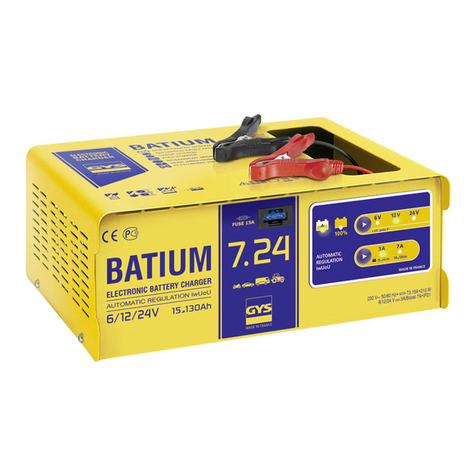
GYS
GYS BATIUM 7/12 User manual
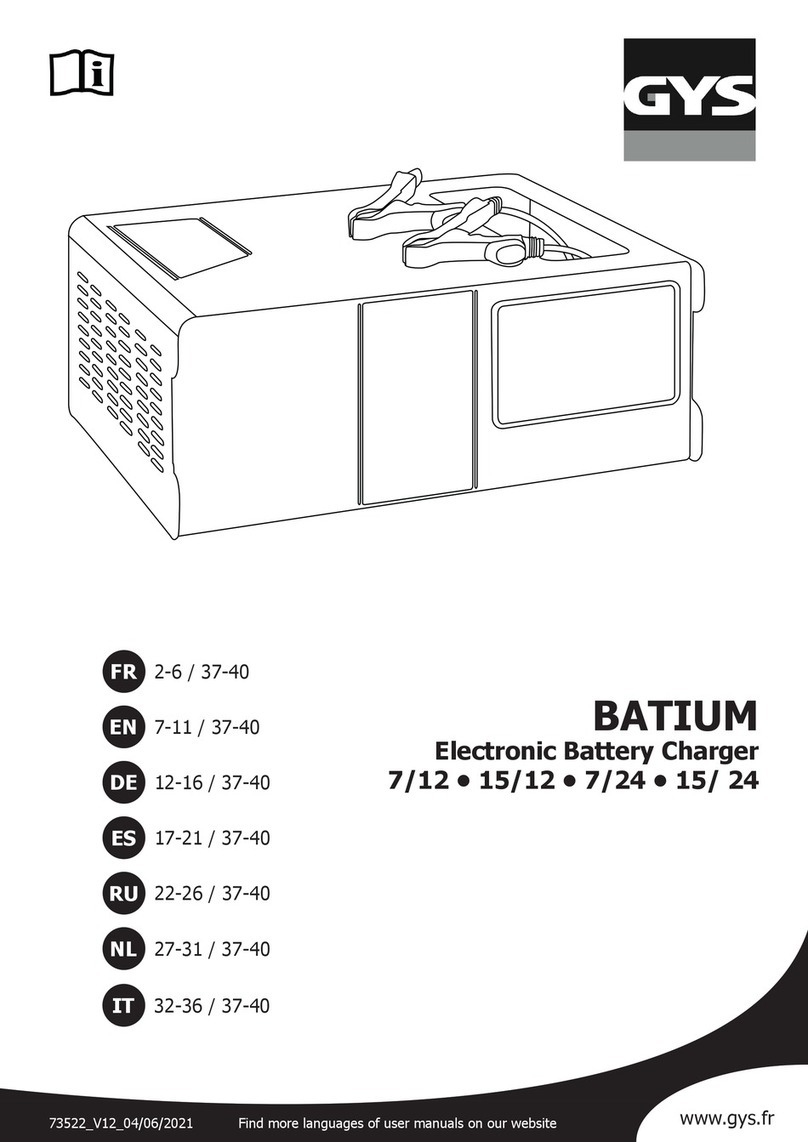
GYS
GYS BATIUM 15/12 User manual
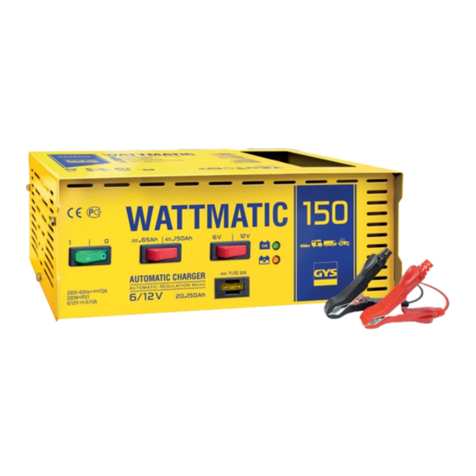
GYS
GYS Wattmatic 100 User manual
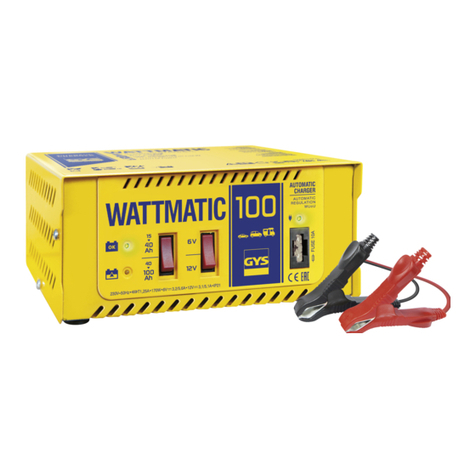
GYS
GYS WATTMATIC 80 User manual
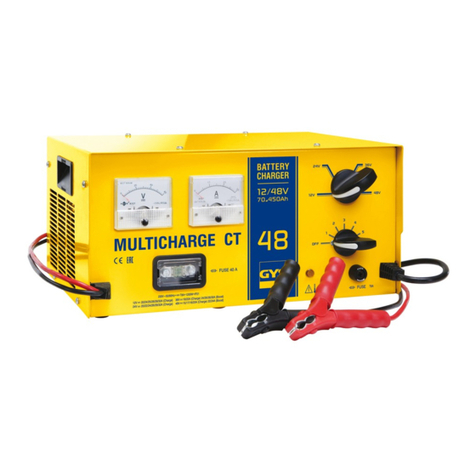
GYS
GYS MULTICHARGE CT 48 User manual
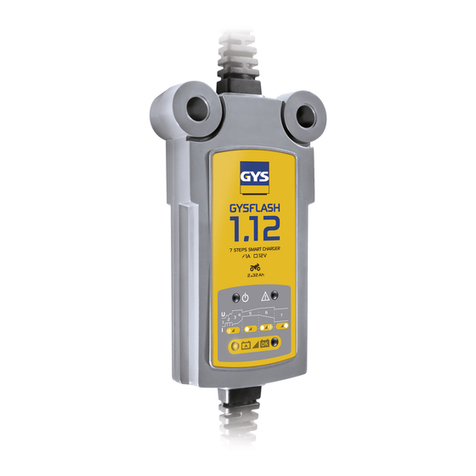
GYS
GYS GYSFLASH 1.12 User manual
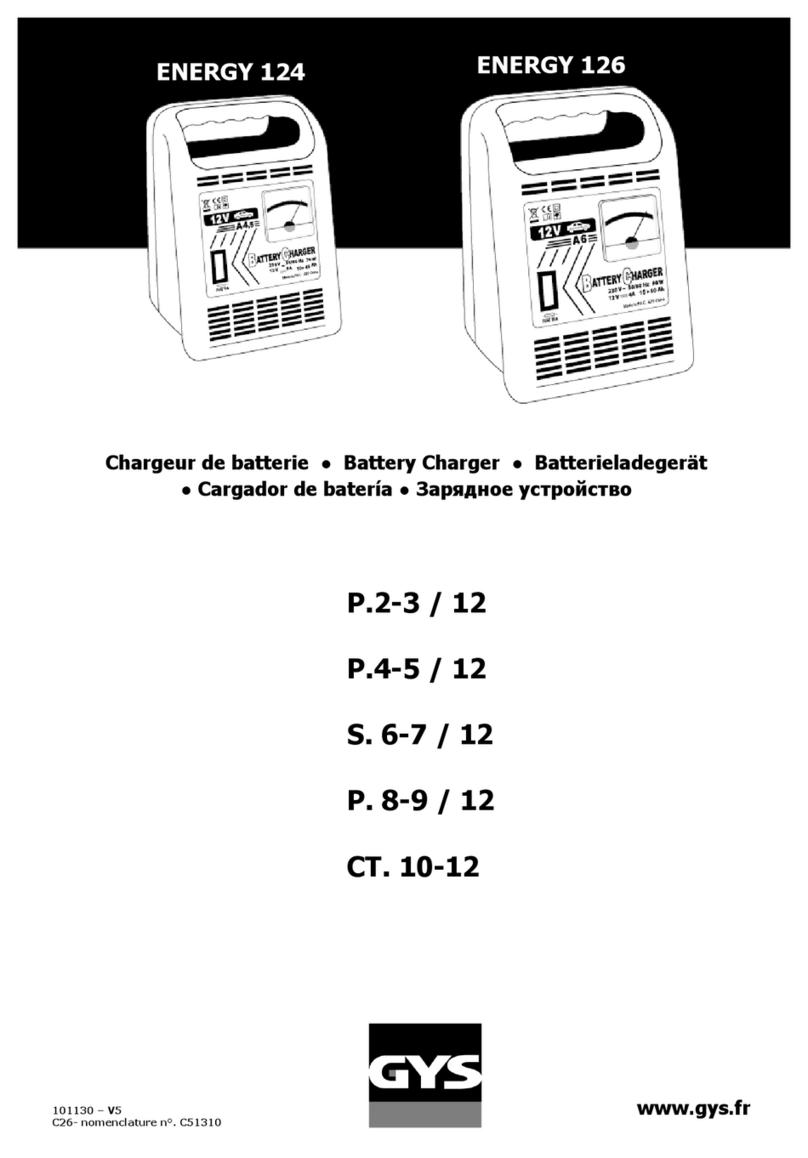
GYS
GYS ENERGY 124 User manual

GYS
GYS GYSFLASH 6.24 User manual
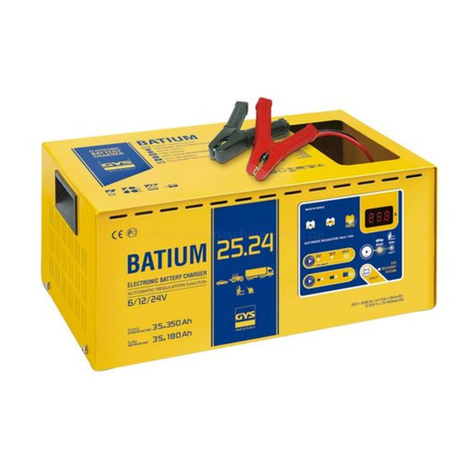
GYS
GYS BATIUM 25/24 User manual
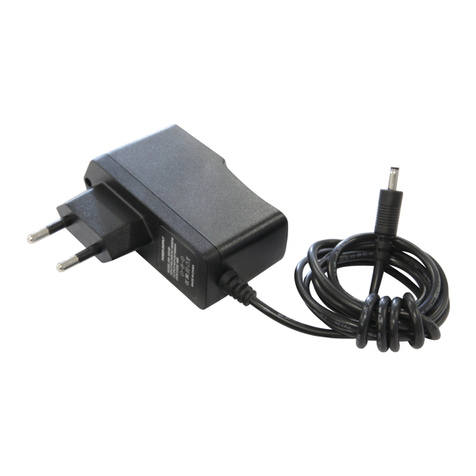
GYS
GYS 14 V CHARGER CIGARETTE LIGHTER User manual
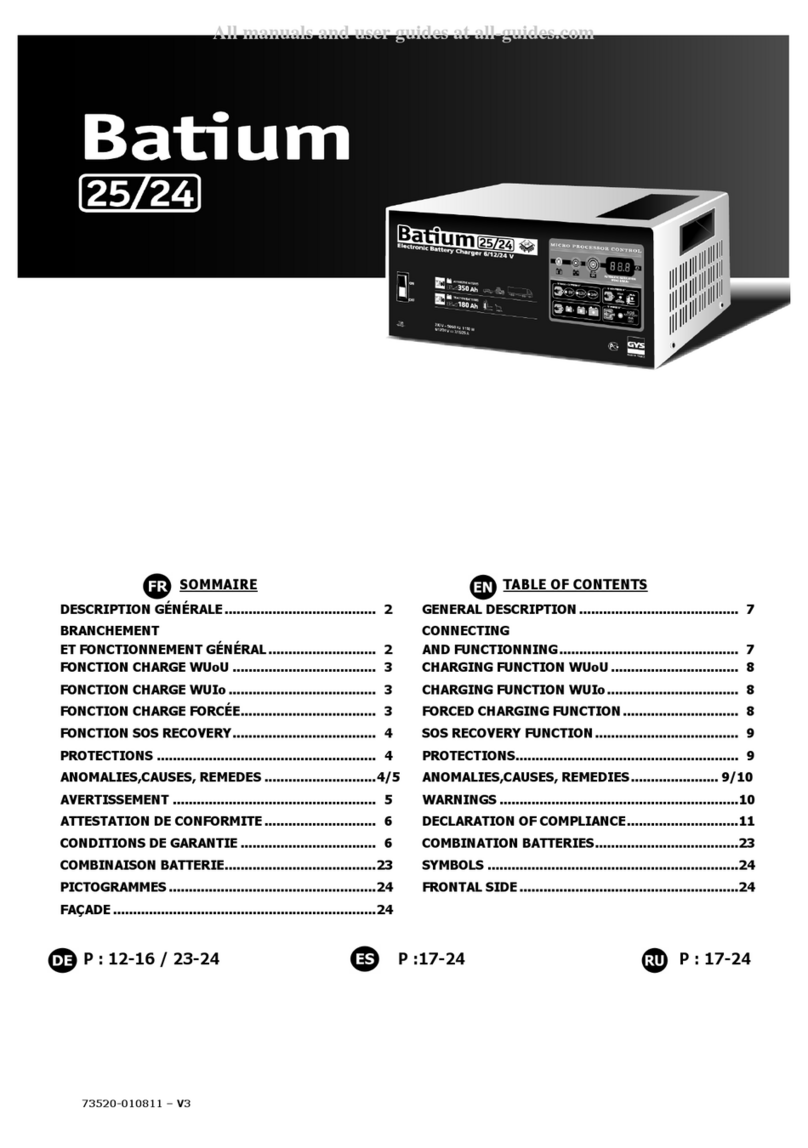
GYS
GYS BATIUM 25/24 User manual

GYS
GYS ENERGY 124 User manual
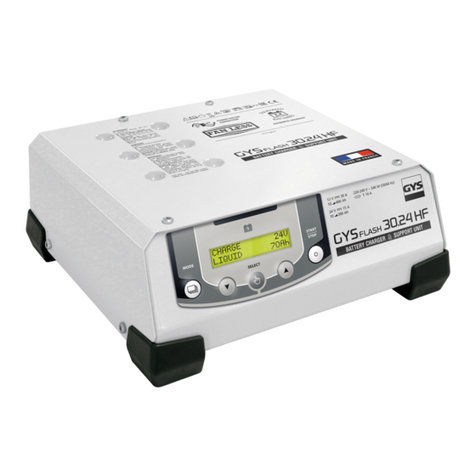
GYS
GYS GYSFLASH 30-24 HF User manual
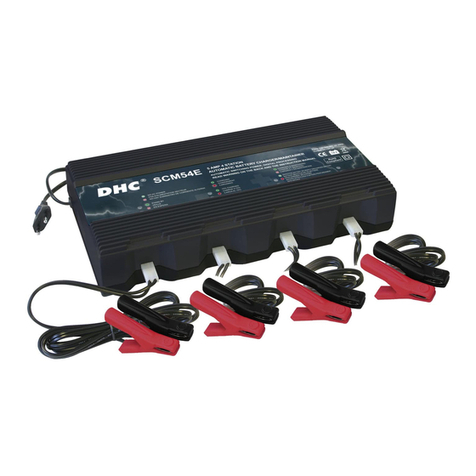
GYS
GYS SCM54E User manual
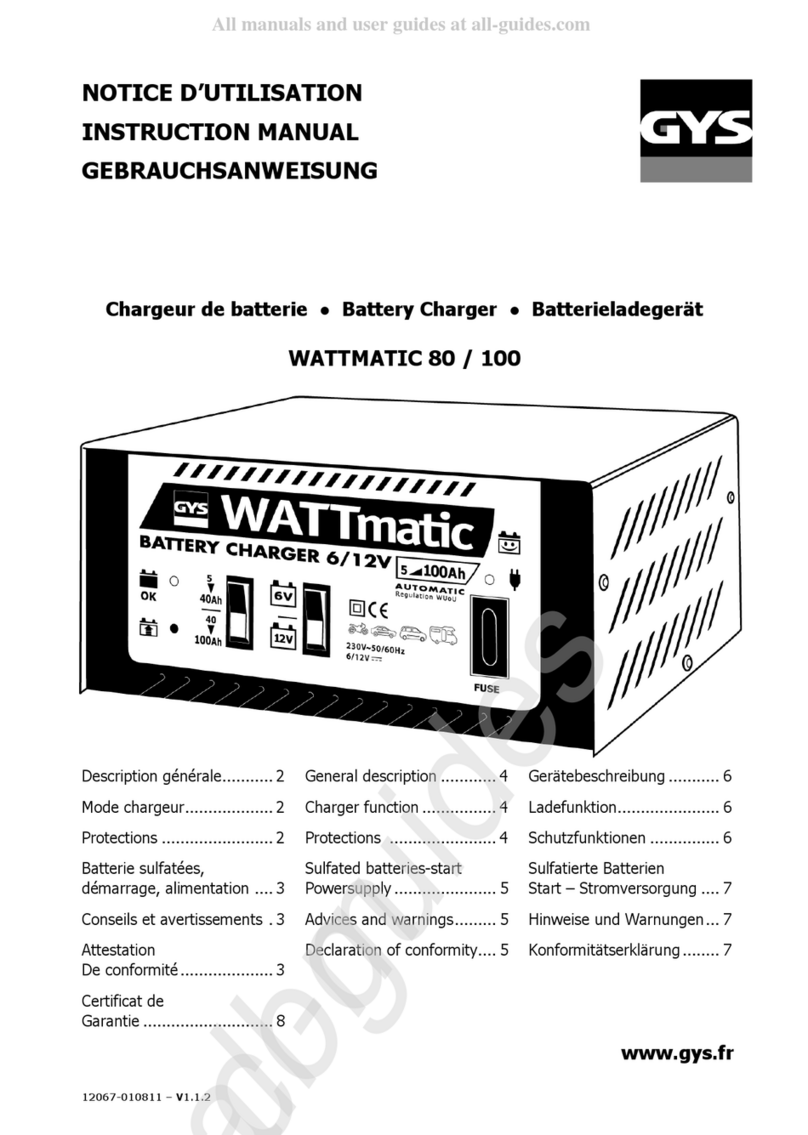
GYS
GYS WATTMATIC 80 User manual

GYS
GYS GYSFLASH 9.24 User manual

GYS
GYS BATIUM 7/12 User manual
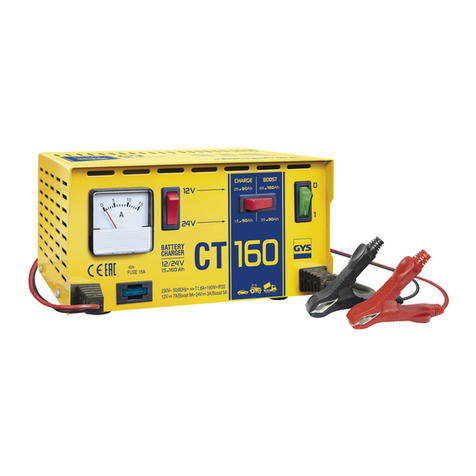
GYS
GYS CT 160 User manual
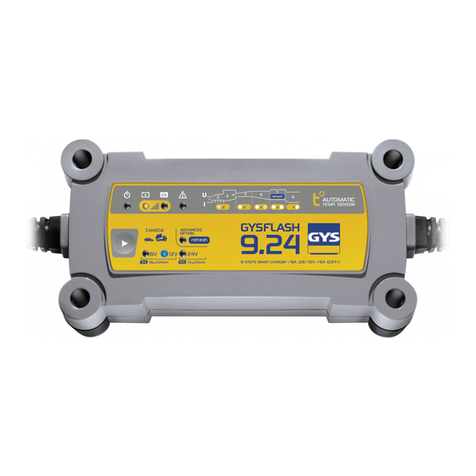
GYS
GYS GYSFLASH 9.24 User manual

GYS
GYS WATTMATIC 80 User manual
